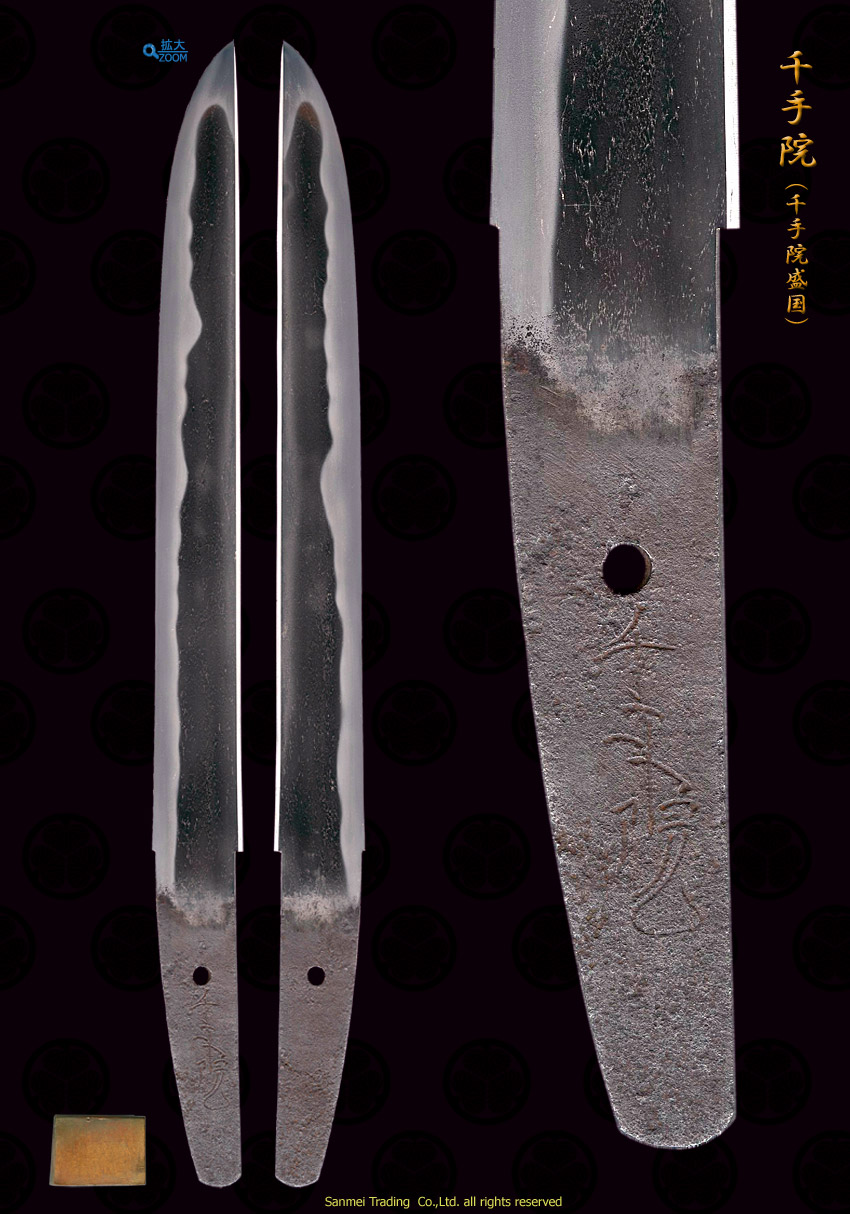Length of cutting edge 28.3cm No curvature Width of base 31.8mm Thickness of base 6.6mm
Kitae(forging pattern) : Kitae is outstanding Itame hada generally with Masame straight indication. The entire steel gives off sparkling martensite particles of Ji-nie glitter that comes from fine steel quenching process where generates darkish gleaming lines so called Chikei activity.
Hamon(tempering pattern) : Hamon state is "Nie" that is rather on stronger side, starts with short straight line of Yakidashi then ranges with small Gunome. Upper the blade taller the Hamon, bigger the Gunome and brighter the Nie further isolated spots or patches of Ji-nie so called Yubashiri quenching activity appear on Hiraji or Mune area to form Hitatsura 皆焼 flamboyant quenching scene.
The interior of temper is filled with misty sparkling Nioi where vividly bright Nie of thick Ashi feet radiates into the cutting edge and gleaming thick lines so called "Sunagashi" appears here and there crossing over the feet and also all over the Hitatsura isolated areas. The entire quench scene shows wide variety of Nie that comes from skilled forging activities from Soushu school to prove his excellent workmanship.
Boshi (tip): Boshi forms large Gunome then large circle where gleaming lines of Hakikake appears frequently then turns back deeply connecting to "Muneyaki" 棟焼.
Nakago(tang) : The tang is UBU original. One Mekugi-ana retaining hole. "O-sujikai" greatly slanting left filemarks and the back ridge of Nakago is a bit contoured with "O-sujikai" with horizontal "Kesho" filemarks. Kurijiri of U-shaped heel. The unique Rensho-tai like style signature is located underneath the Mekugi-ana, three character SENJUIN 千手院. The entire Nakago preserves clear mark of inscription with an excellent taste of patina.
During the Edo period, the capital of Bushu Edo and the other major castle towns flourished in peace. Not only powerful clans or high class Samurais but also wealthy merchants were mostly eager for artistic elements or pray for divine protection especially on the tanto with the worshipping natural forces "Gods exist in it".
The subject Tanto with inscription SENJUIN 千手院 was a quite rare extant work of MORIKUNI 盛国 who was a distant descendant of Akasaka SENJUIN 赤坂千手院 from Mino province who is listed in the rank of JOSAKU "superior made".
He joined and learned from Izumi-no-kami KANESHIGE 和泉守兼重 with the famed fellow students of Kazusa-no-kami KANESHIGE 上総守兼重 and Nakasone KOTETSU 長曽根虎徹.
He enjoyed an official district title of Izumi-no-kami 和泉守 which was granted by the Imperial Court and initially had named himself as MORIMASA 守正 with a name of clan Minamoto 源 then later changed his name as MORIKUNI 盛国.
MORIKUNI 盛国 is tied for the leading swordmakers matching with Nakasone KOTETSU 長曽根虎徹, Kazusa-no-kami KANESHIGE 上総守兼重 and Yamato-no-kami YASUSADA 大和守安定 in Bushu Edo during Kanbun period.
Most of his extant works are inscribed including his source of origin SENJUIN 千手院 such as Izumi-no-kami Senjuin Minamoto MORIMASA-saku 和泉守千手院源守正作 or Izumi-no-kami Senjuin MORIKUNI-saku 和泉守千手院盛国作.
Almost all extant works of him are Katana or Wakizashi of Shinogi-zukuri construction therefore it is quire rare to come across the tanto like this example. It is supposed that this tanto would be made by special demand for dedication to the temple because both the title of Izumi-no-kami 和泉守 and his smith name MORIKUNI 盛国 were intentionally left out but inscribes only the name of temple SENJUIN 千手院 that had been closely related with sword makers since late Heian / Kamakura period.
It's noteworthy that this tanto still remains almost mint condition for the age of 350 years and holds magnificent shape and shows rich activities of Nie.
Copper original Habaki collar preserved in Shira-saya plain wood mounting.
Fresh polish/Condition scale: mint - excellent (using a scale of mint-excellent-very good-good-fair-poor)

